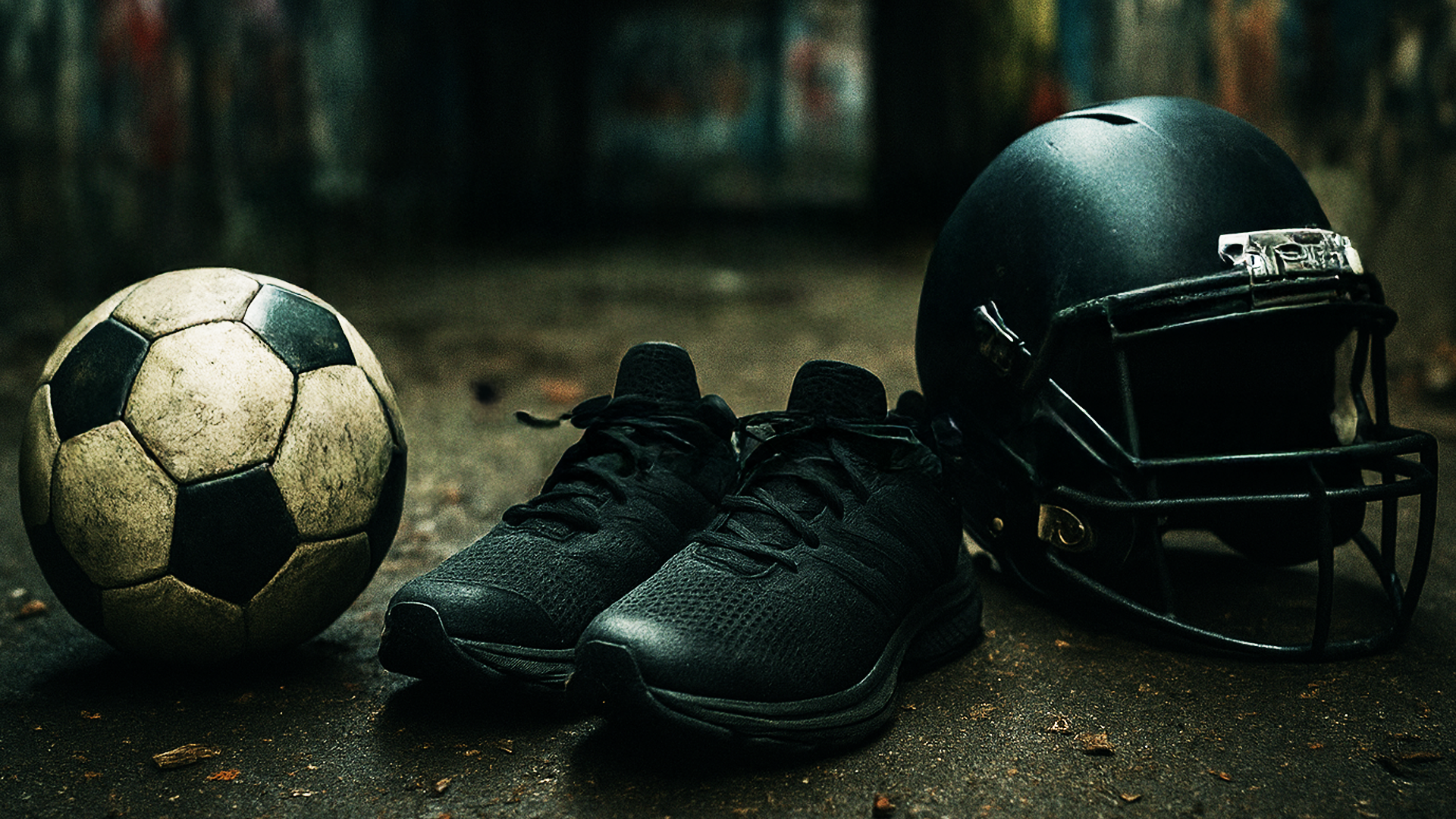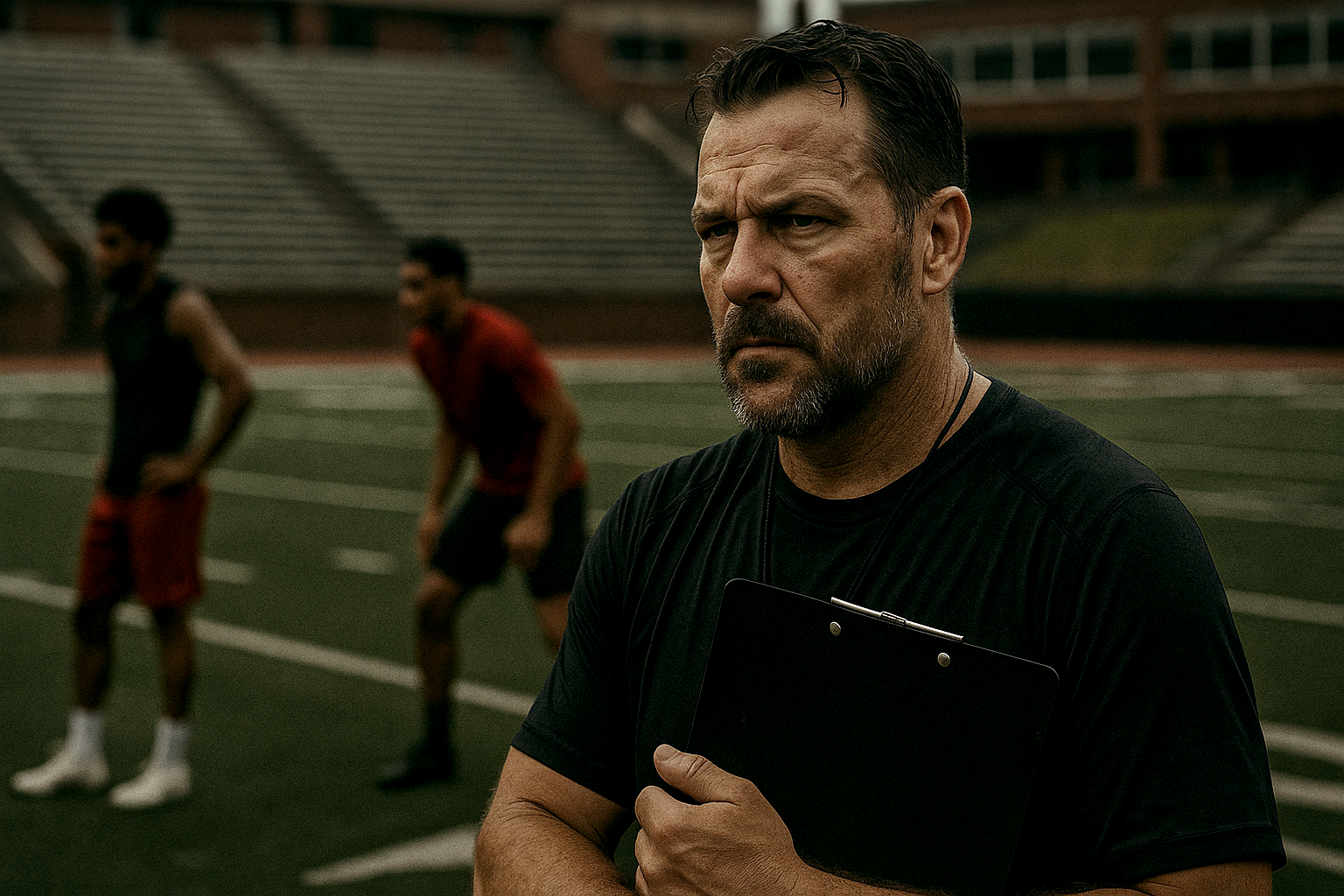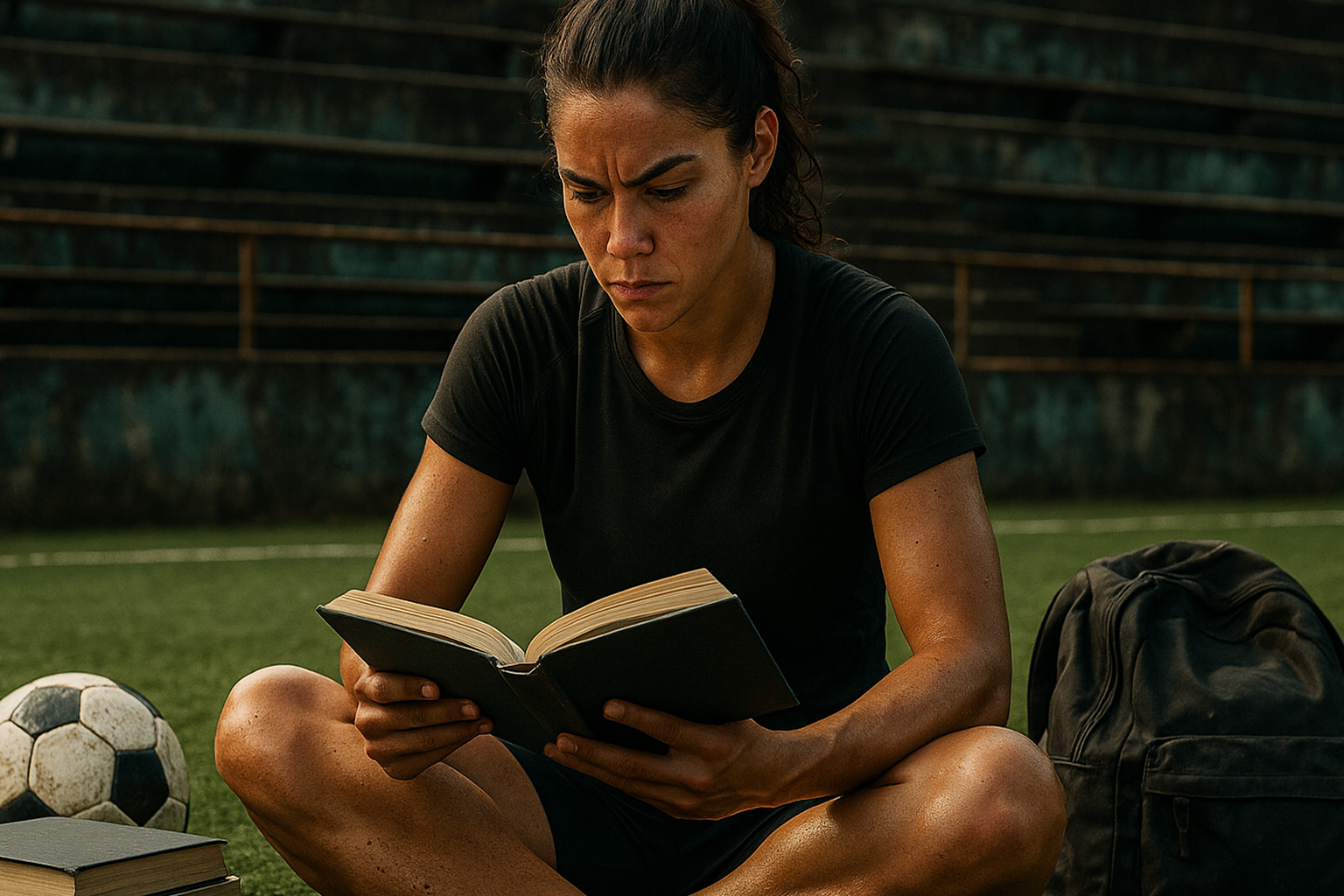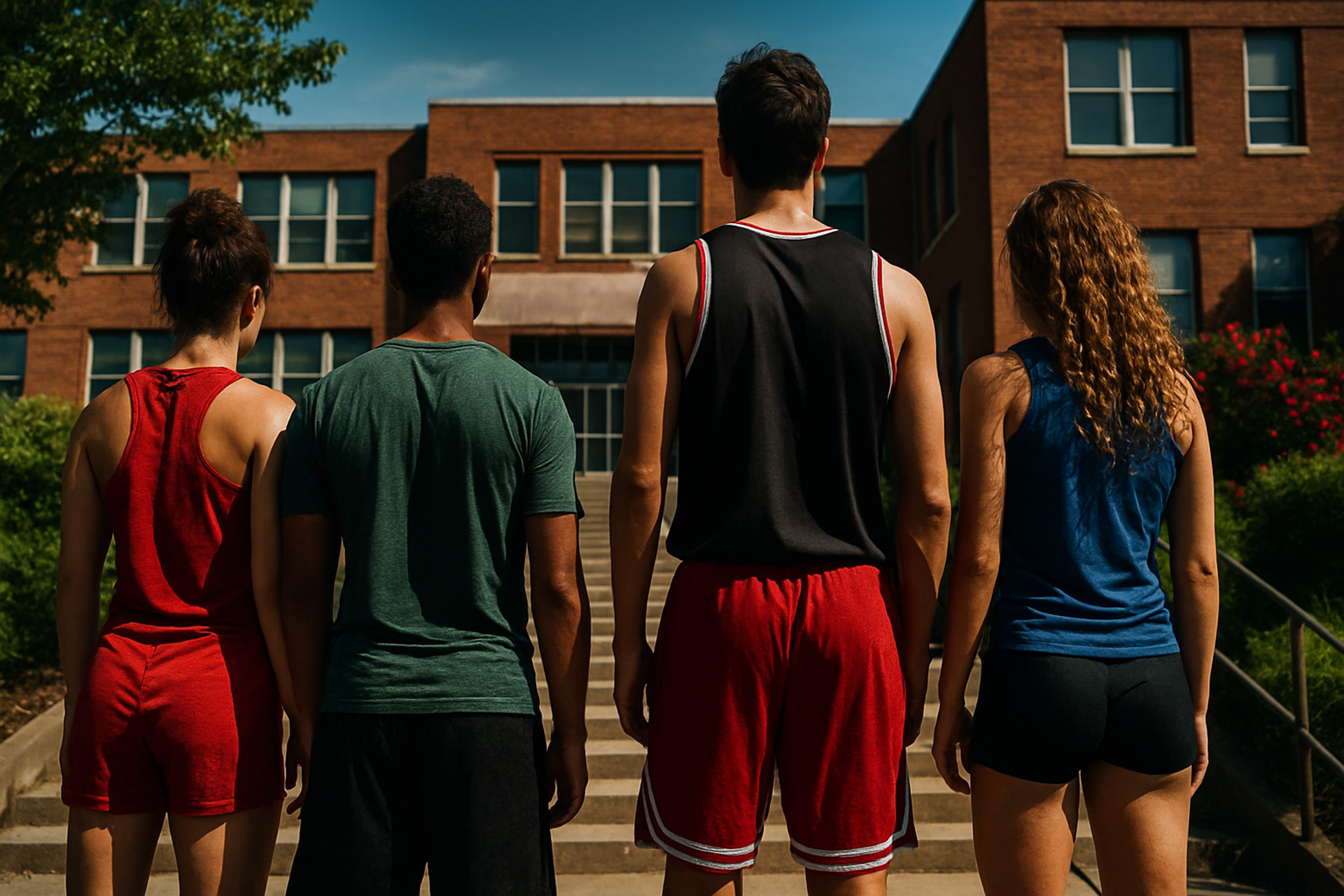Athletic gear has changed. It no longer serves just one purpose. Today, equipment is designed to help athletes perform better and stay safe at the same time.
Recent research has helped explain how clothing, shoes, and equipment affect the body. Scientists now study how materials, shapes, and features can affect movement, recovery, and injury prevention. These studies have led to new designs that are tested in labs before they are used in training or competition.
This article explores how research-backed athletic equipment works. It looks at how gear is made, what it is tested for, and how it fits into performance and protection goals across different sports.
UNDERSTANDING THE DUAL ROLE OF ATHLETIC EQUIPMENT FOR PERFORMANCE AND PROTECTION
Modern athletic equipment serves two main functions: enhancing physical performance and reducing the risk of injury. These two roles were once managed by separate types of gear – one for protection, the other for performance. Now, research has shown that the most effective equipment combines both.
For example, soccer shin guards can reduce tibia fracture risk significantly, with materials and structural characteristics making a big difference in protective abilities. In baseball, helmets with face guards lower facial injury rates dramatically in youth leagues. These aren't guesses – they're measured results from testing.
WHAT MAKES GEAR RESEARCH-BACKED?
It means the design process includes scientific testing rather than just focusing on looks or marketing. Designers use motion analysis, pressure mapping, and impact testing to create better equipment.
Some key differences between traditional and research-informed design approaches:
- Traditional design relies on past models and visual appeal
- Research-informed design uses biomechanics and injury data
- Research-backed testing includes lab validation and user trials
- Traditional testing is limited or subjective
This approach to performance and protection has become standard in high-level sports and is now expanding to gear used by youth and recreational athletes.
HOW RESEARCH-DRIVEN DESIGNS MINIMIZE INJURY RISK
Scientific studies show that properly designed athletic gear can reduce injuries. When equipment is created using biomechanical data (the study of how the body moves), it can support joints, absorb impact, and distribute force in ways that lower injury risk.
Injury data collected over time shapes new gear designs. For example, high injury rates in football led to helmets that now undergo testing across hundreds of simulated collision scenarios. These updates reflect a shift from general design to data-informed modifications that address common injury patterns.
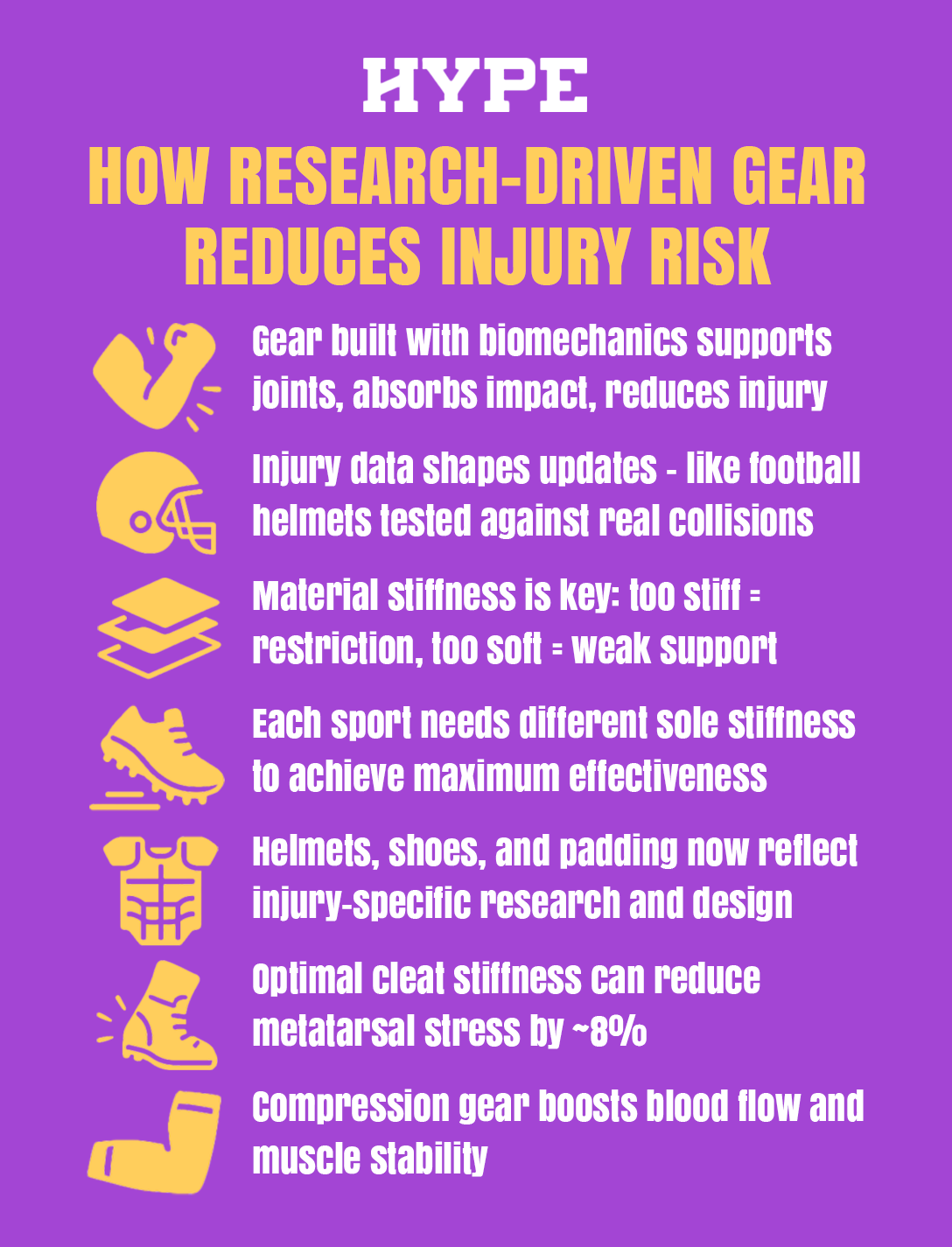
TLDR – How research-driven gear reduces injury risk:
- Gear built with biomechanics supports joints, absorbs impact, and lowers injury risk.
- Injury data shapes updates – like football helmets tested against real collisions.
- Material stiffness is key: too stiff = restricted movement, too soft = weak support.
- Each sport needs different sole stiffness to achieve maximum effectiveness.
- Helmets, shoes, and padding now reflect injury-specific research and design.
- Optimal cleat stiffness can reduce metatarsal stress by ~8%.
- Compression gear boosts blood flow and muscle stability.
STIFFNESS & FLEXIBILITY IN GEAR
Material properties like stiffness and flexibility play a key role in reducing injury risk. Researchers study how different levels of these properties affect the body during athletic activity. Gear that's too stiff can restrict movement, while gear that's too flexible may not provide enough support. The goal is finding the optimal middle ground for each sport.
Footwear is one area where stiffness has been closely studied. In football cleats, the stiffness of the plate under the foot can influence how force travels through the bones. Studies show that optimal plate stiffness in football cleats can reduce metatarsal stress by nearly 8%, moderately lowering fracture risk.
Different sports require different stiffness profiles:
- Running: Moderate stiffness in the midsole for forward motion
- Football: Higher plate stiffness for stability on turf
- Basketball: Lateral stiffness to manage side-to-side movement
SUPPORTIVE & PROTECTIVE FEATURES
Modern athletic gear includes specific features designed to protect the body based on research findings. These features are tested to confirm they actually work in supporting muscles, bones, and joints during high-intensity movements.
Compression gear applies controlled pressure to the body, which can stabilize muscles and promote blood flow. Helmets now include multi-layered padding to absorb shock. Athletic shoes often include heel counters and arch structures that guide foot movement and reduce joint stress.
EXPLORING MATERIALS SCIENCE IN MODERN ATHLETIC APPAREL
Materials science plays a key role in how athletic clothing functions. Modern fabrics are tested for properties like durability, moisture control, and temperature regulation.
Testing includes checking how much wear a fabric can handle before breaking down, how well it moves sweat away from the skin, and how it helps maintain body temperature during exercise. These research methods help determine how fabric design impacts comfort and performance.
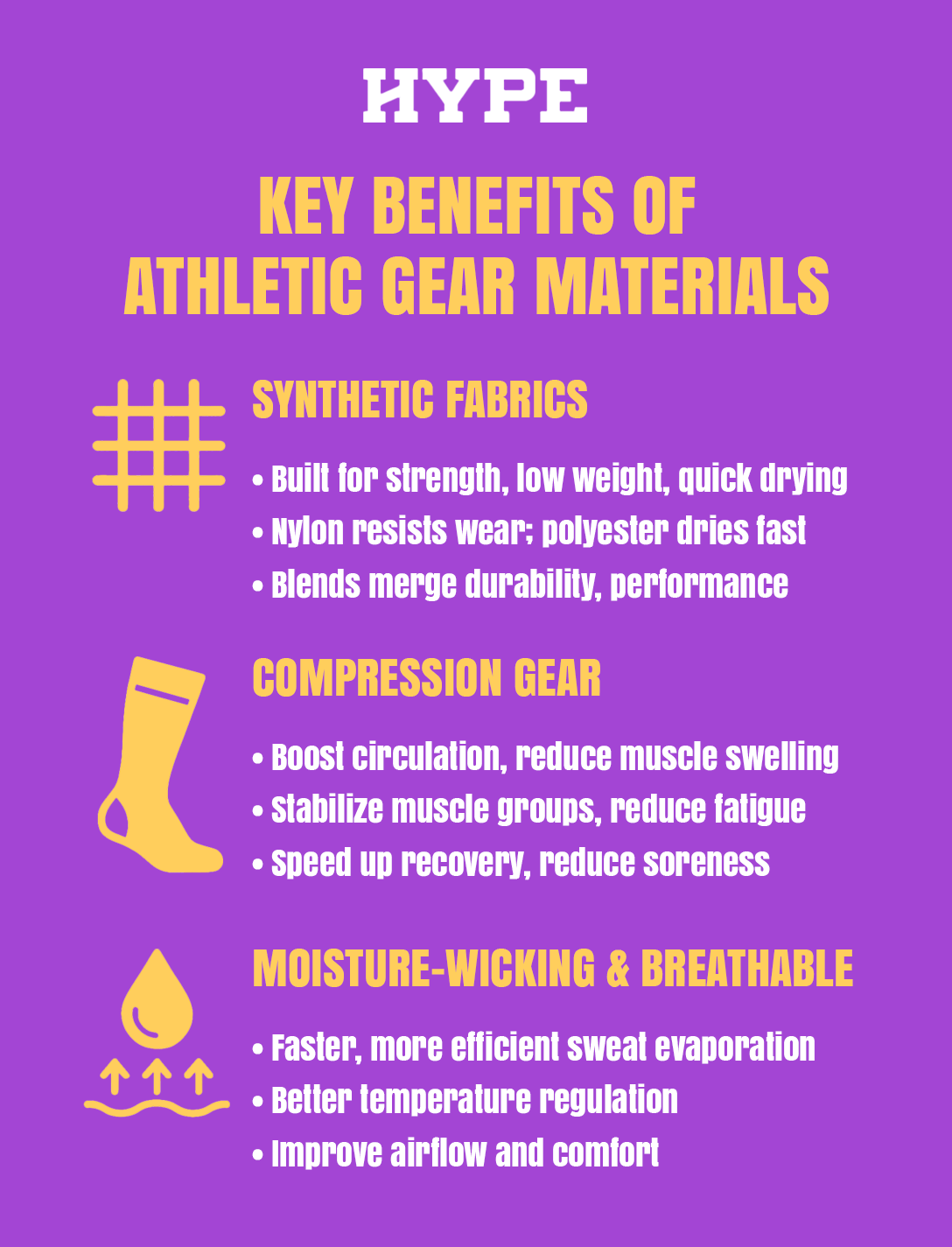
TLDR – Key benefits of research-backed athletic gear materials:
Synthetic fabric benefits:
- Engineered for strength, light weight, and fast drying.
- Nylon resists wear and abrasion; polyester microfiber dries quickly.
- Blended fabrics combine multiple advantages for performance and comfort.
Compression gear benefits:
- Boosts blood circulation and reduces muscle swelling.
- Stabilizes muscle groups, cutting down vibration and fatigue.
- Speeds up recovery and reduces post-workout soreness.
Moisture-wicking and breathability benefits:
- Pulls sweat away from skin for faster evaporation.
- Helps regulate body temperature during intense activity.
- Uses mesh and hydrophobic fibers to improve airflow and comfort.
LIGHTWEIGHT SYNTHETIC FABRICS
Synthetic fabrics have replaced many natural materials in athletic clothing due to their engineered properties. Materials like nylon and polyester are designed at the molecular level to achieve specific goals such as high strength, low weight, and quick drying.
These fabrics are created by adjusting polymer chains – long molecules that determine how the material feels and performs. Researchers develop these fabrics by testing how strong they are compared to their weight, and how they respond to stretching, movement, and exposure to sweat.
The differences between synthetic fabrics:
- Nylon has high strength and good resistance to rubbing
- Polyester microfiber dries faster than traditional materials
- Modern blends combine multiple benefits into one fabric
COMPRESSION BENEFITS
Compression garments apply controlled pressure to specific areas of the body. Studies show this pressure affects blood flow, muscle movement, and recovery after exercise.
Research indicates compression increases venous return – the movement of blood back to the heart. This may reduce swelling and improve oxygen delivery to muscles. Compression also stabilizes muscle groups, which can reduce vibration and fatigue during repetitive movement.
Proven compression benefits:
- Increased circulation during and after activity
- Reduced muscle vibration during high-impact movement
- Faster recovery of strength after exercise
- Decreased muscle soreness following intense workouts
MOISTURE-WICKING & BREATHABILITY
Moisture-wicking fabrics move sweat away from the skin to the outer surface of the garment, where it can evaporate. This prevents the fabric from becoming saturated and helps regulate body temperature during activity.
Scientists test moisture-wicking ability by measuring how sweat moves through fabric samples. They also study how fabrics affect the body's ability to maintain a stable temperature during exercise in warm or humid conditions.
How moisture-wicking technologies work:
- Capillary action draws moisture through narrow gaps between fibers
- Hydrophobic (water-repelling) fibers push liquid away from the skin
- Mesh structures create air channels for improved evaporation
Advanced fabrics sometimes use phase change materials that absorb and release heat depending on the athlete's body temperature. These materials help maintain temperature within a narrow range during repeated exertion cycles.
INNOVATIONS SHAPING ATHLETIC FOOTWEAR & CLEAT DESIGN
Athletic footwear design uses scientific tools to improve function and reduce injury. Motion capture tracks how an athlete moves in three dimensions. Pressure mapping shows how force is distributed across the foot. Materials testing measures how each part of the shoe responds to stress and repeated use.
Different sports require different movements, so footwear design changes depending on the sport. Basketball shoes focus on lateral support, while running shoes focus on forward propulsion and energy return.
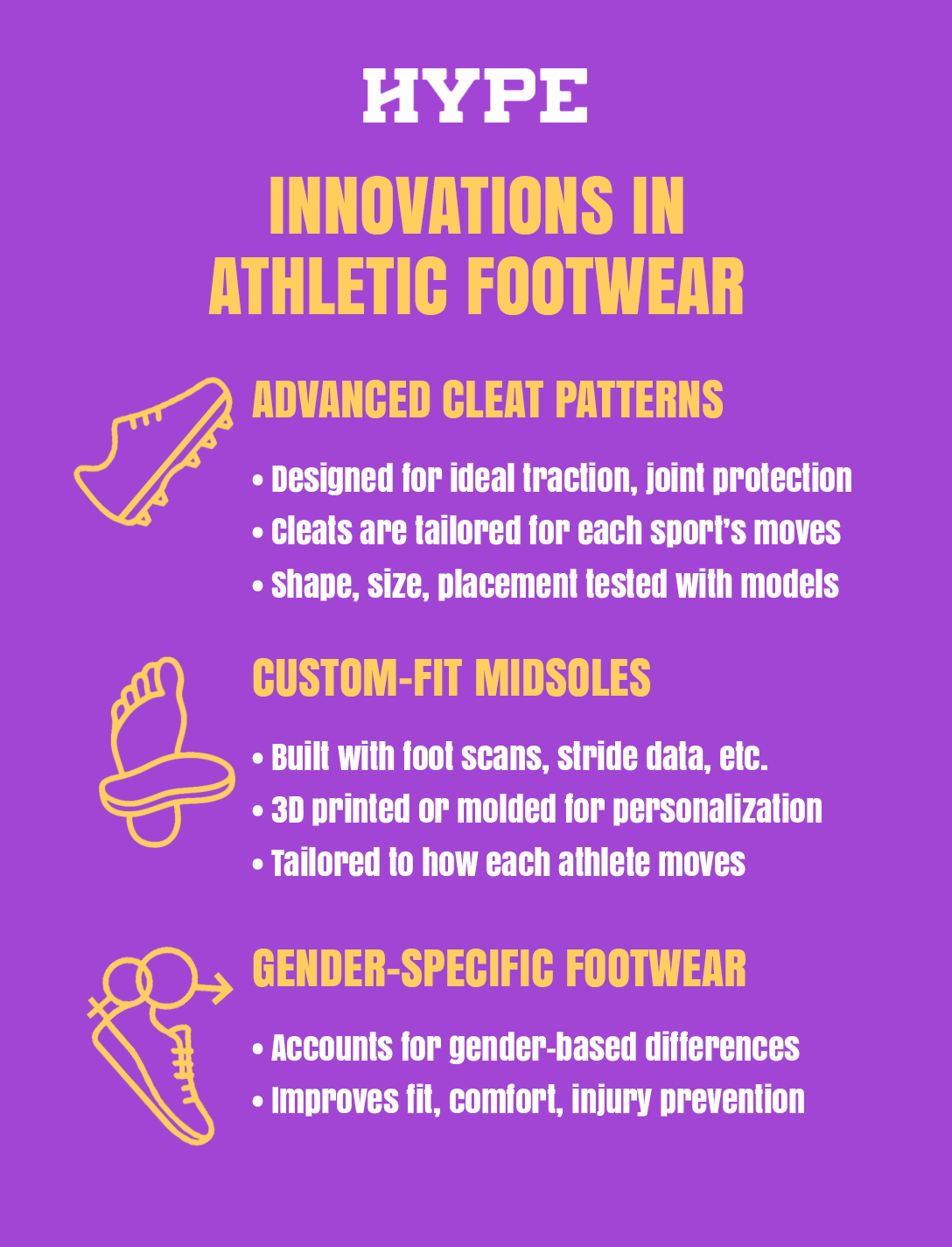
TLDR – Research-backed innovations in athletic footwear:
Advanced cleat patterns:
- Designed for ideal traction with joint-protective release.
- Football cleats support quick cuts; soccer cleats allow rotational movement.
- Shape, size, and placement are tested with biomechanical models.
Custom-fit midsoles:
- Built using foot scans, stride data, and pressure mapping.
- 3D printed or molded for personalized support and movement.
- Tailored to how each athlete runs, jumps, and lands.
Gender-specific footwear:
- Accounts for female-specific foot shape, muscle distribution, and gait.
- Includes flexible uppers, custom midsoles, and stride-based outsole shapes.
- Improves fit, comfort, and injury prevention for women athletes.
ADVANCED CLEAT PATTERNS
Cleat patterns have evolved based on studies about traction and injury prevention. Traction is the grip between the shoe and the playing surface. Poor traction can lead to slipping, while too much traction can stop the foot too quickly, increasing strain on joints.
The ideal cleat pattern allows enough grip for performance but also permits some controlled release to protect joints from excessive force.
Researchers use biomechanical models to study how cleat shape, size, and placement affect movement. In football, cleats are tested for how well they support quick changes in direction. In soccer, cleats are designed to allow more rotational movement to reduce knee stress.
CUSTOM-FIT MIDSOLES
Custom midsoles are created using individual biomechanical data. Shoe designers collect information on foot shape, arch height, pressure patterns, and stride mechanics. This information is used to make midsoles that match how a person runs, jumps, and lands.
3D printing and molding technologies allow for detailed customization. Materials are selected based on how much support, flexibility, or stiffness is needed in certain parts of the foot.
Steps in creating custom-fit midsoles include:
- Scanning the foot to collect data on shape and pressure
- Analyzing movement patterns using motion capture
- Designing a midsole structure aligned with the athlete's needs
- Manufacturing using 3D printing or custom molding
- Testing during sport-specific movement
GENDER-SPECIFIC FOOTWEAR RESEARCH
Footwear design has evolved to reflect anatomical differences between male and female athletes. Earlier designs often used male foot models for all shoe sizes, leading to poor fit for many female athletes.
Female feet typically have a narrower heel, wider forefoot, and different arch shape. Muscle distribution, joint flexibility, and hip-to-knee alignment also differ between sexes. These differences affect how force travels through the leg during movement.
Recent breakthroughs in women's athletic footwear include:
- Midsoles with different density zones based on female-specific pressure patterns
- Upper designs with flexible materials that adapt to foot swelling during long sessions
- Outsole shapes that match typical female stride patterns
DATA-DRIVEN PERFORMANCE & WEARABLE TECHNOLOGY
Modern athletic gear often includes technology that collects and analyzes data to improve design and performance. This process uses sensors to track how athletes move, how their bodies respond to training, and how equipment interacts with the body during activity.
Wearable sensors in shoes, clothing, and accessories collect data in real time. This information helps athletes, coaches, researchers, and designers study movement patterns and make informed adjustments to technique or equipment.
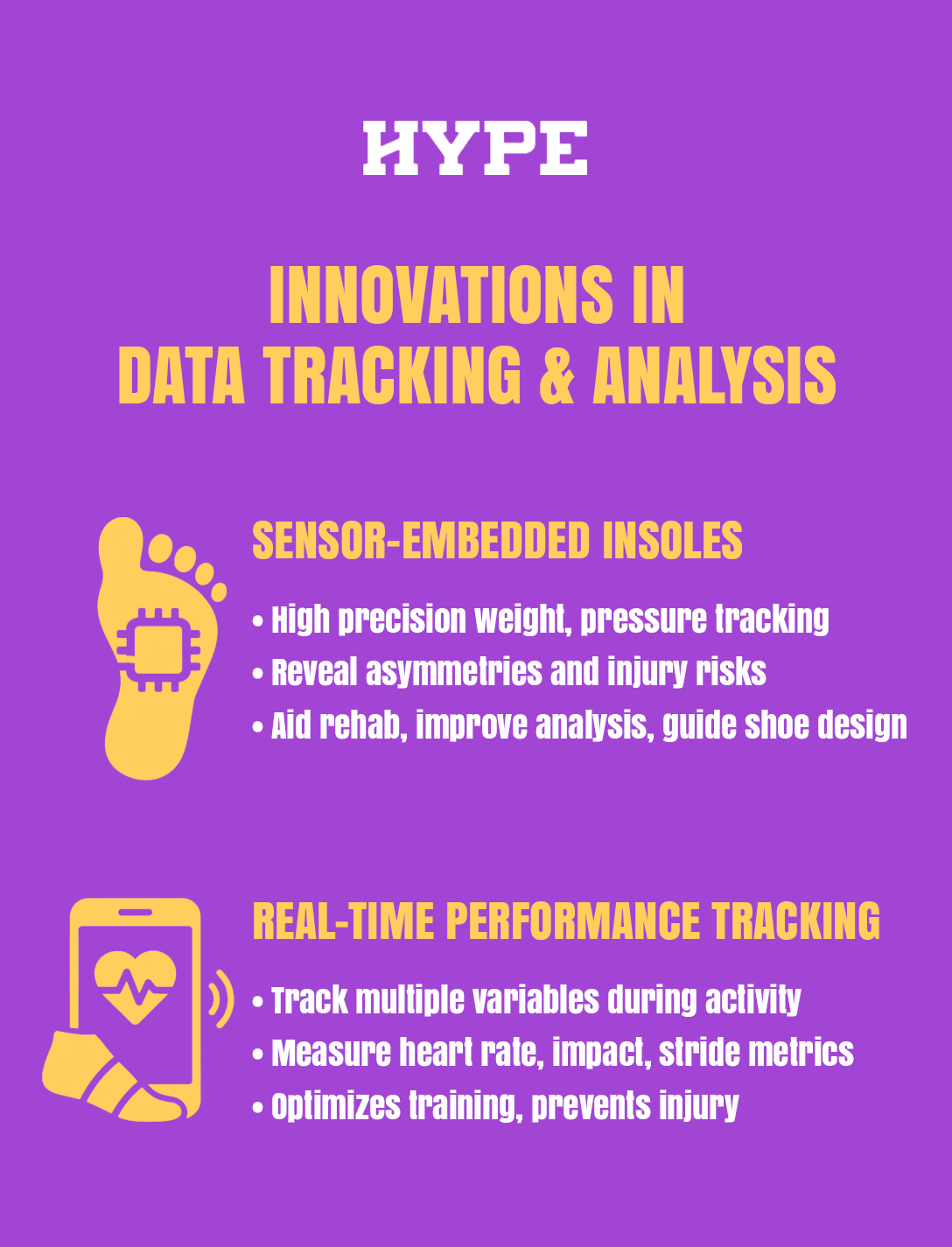
TLDR – Innovations in wearable technology and data tracking:
Sensor-embedded insoles:
- Track pressure distribution and weight shifts with high precision.
- Reveal asymmetries, pressure points, and injury risks.
Aid rehab, improve movement analysis, and guide shoe design.
Real-time performance tracking:
- Uses GPS, heart rate monitors, and accelerometers during activity.
- Measures heart rate, acceleration, contact time, impact, stride metrics.
- Helps optimize training, prevent injury, and adjust technique on the fly.
SENSOR-EMBEDDED INSOLES
Sensor-embedded insoles contain pressure sensors that measure how force is applied across different parts of the foot during movement. These sensors can detect small changes in movement that aren't visible to the eye.
These insoles can measure force distribution with millisecond precision, identifying movement patterns that would otherwise go unnoticed.
The data collected by these insoles helps:
- Monitor weight shifts during running, jumping, or cutting
- Identify pressure points that may increase injury risk
- Assess symmetry between left and right foot strikes
- Track progress during rehabilitation after injury
- Guide footwear designers in adjusting cushioning and support
In basketball and football, this technology helps analyze how players land after jumps or changing direction. In running, it helps determine if shoes are distributing pressure evenly across the foot.
REAL-TIME PERFORMANCE TRACKING
Wearable technology that tracks performance includes devices like GPS units, accelerometers, and heart rate monitors. These devices measure physical data while an athlete trains or competes. The data helps understand how the body is working and how to adjust training or equipment choices.
Common performance metrics and their applications:
- Heart rate – Monitors intensity and recovery capacity
- Acceleration – Evaluates explosiveness in sprinting or jumping
- Ground contact time – Assesses running efficiency
- Impact force – Evaluates injury risk in jumping sports
- Stride length/cadence – Used to improve running form
Athletes and coaches use this information to make decisions about rest, workload, and technique adjustments. For example, if an athlete's ground contact time increases during a workout, this may signal fatigue, suggesting it's time to reduce training intensity or focus on recovery.
WHERE TO GO NEXT FOR LONG-TERM PERFORMANCE GAINS
Research-backed athletic gear functions as a tool. It supports performance and reduces injury risk, but it doesn't replace the role of training or mental preparation. Athletic development includes physical conditioning, technical skill, recovery, mental focus, and the environment in which the athlete trains.
Equipment is one component of that system. Its effectiveness depends on how it interacts with the athlete's body, training demands, and sport-specific movements. Research shows that performance gains are more consistent when equipment is used alongside structured training programs.
Even the most advanced gear is only as effective as the athlete using it – which is why comprehensive development matters.
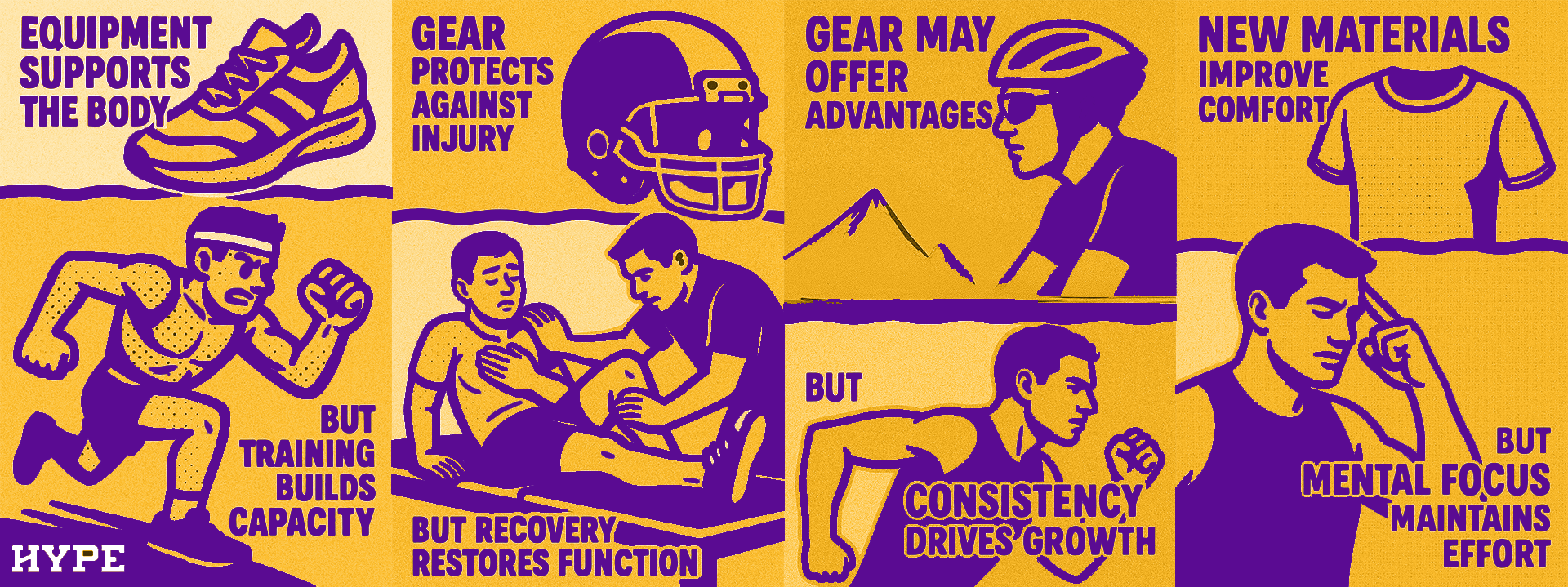
The relationship between gear, training, and mindset includes:
- Equipment supports the body, but training builds capacity.
- Gear protects against injury, but recovery restores function.
- Gear may offer advantages, but consistency drives growth.
- New materials improve comfort, but mental focus maintains effort.
Athletes looking for complete development often use tools that integrate multiple aspects of their journey. The HYPE app provides educational content, peer connection, and performance tracking. It supports the whole athlete – not just in gear selection, but in building routines, tracking progress, and staying aligned with long-term goals.
FREQUENTLY ASKED QUESTIONS ABOUT ATHLETIC GEAR
HOW CAN I TELL IF ATHLETIC GEAR IS TRULY RESEARCH-BACKED OR JUST MARKETING HYPE?
Look for references to specific studies, testing methods, or patented technologies from the manufacturer. Legitimate research-backed gear will cite data from peer-reviewed sources or standardized testing protocols rather than relying solely on athlete endorsements or vague claims about "revolutionary design."
WHAT PRICE DIFFERENCE SHOULD I EXPECT BETWEEN RESEARCH-BACKED ATHLETIC EQUIPMENT & STANDARD OPTIONS?
Most athletic gear these days is built on research and scientific insights – from Nike and Adidas to Altra and Asics. However, if you’re looking for top-of-the-line customized gear, expect to pay a fair amount more – possibly 15-30% – than standard options due to specialized materials along with the measurement and testing required to create a custom fit.
HOW OFTEN SHOULD I REPLACE MY ATHLETIC SHOES TO MAXIMIZE BENEFITS?
Most research indicates athletic shoes should be replaced after 300-500 miles of use, as midsole compression and outsole wear can significantly reduce support and performance. Visual signs like uneven tread wear or visible midsole creasing also signal it's time for replacement.
WHAT ATHLETIC GEAR CONSIDERATIONS ARE MOST IMPORTANT FOR YOUTH ATHLETES?
Youth athletic gear should prioritize proper fit and growth accommodation over advanced performance features. Research shows developing bodies benefit most from equipment that allows natural movement while providing basic protection, with an emphasis on comfort and proper alignment rather than specialized performance technologies.
